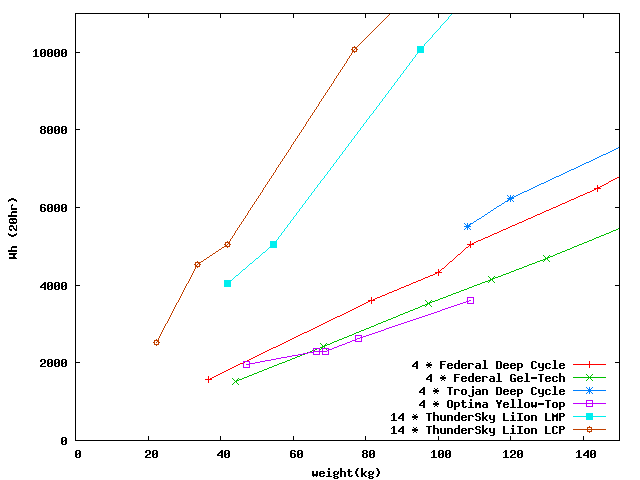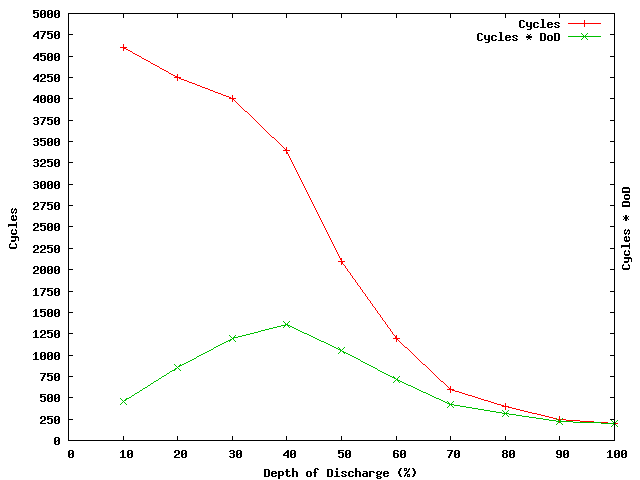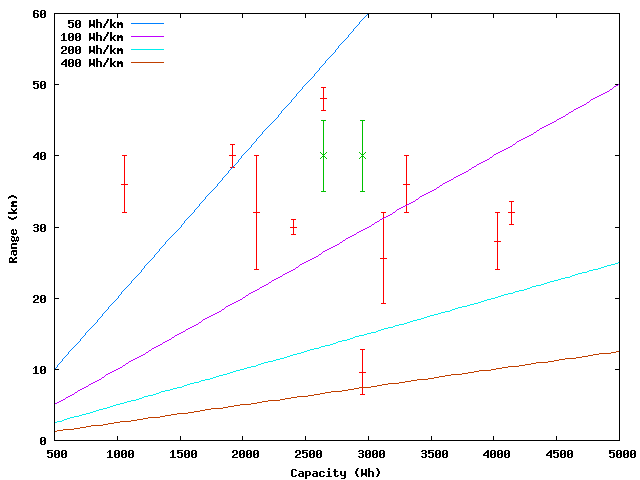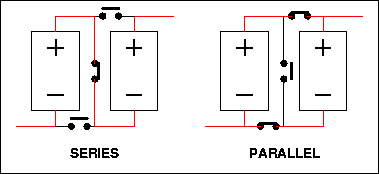

Electric Motorcycles | eMC |
G'day all,I just stumbled onto this list a couple of days ago, and I'm still reading back through the archives. Some of the things in the photo album look fantastic! Since the questions about the Z550 have lured me out of hiding I figure I should introduce myself.
I'm a 33yo software hacker from Melbourne, Australia, with a bit of an EE background and an obsession with motorcycles of all kinds. At the moment my main bike is a BMW R100GS, but it's a bit of a handful around town. I'm interested in seeing if an electric motorcycle would be feasible for me to build and use day-to-day.
So far I'm thinking:
- Electric motor with 10-20hp peak and maybe 1-2hp continuous.
- Simple chain drive to rear wheel.
- About 80kg of sealed batteries in case it falls over -- maybe Optima Yellow Top? Either a 48V or a 60V system.
- Some kind of twistgrip controller. Are regenerative ones available in this power range?
- Some kind of onboard charger, so the bike can just be plugged in to the 240V mains and left overnight / at work / etc.
- All shoehorned into a rolling chassis from a streamlined 250-400cc commuter would be about right ... kerb weight about 160kg before, less than 200kg after I hope.
Does this sound reasonable?
I've gone through the bikes in the photo album and going by the stated ranges and battery configs, the efficiency seems to vary enormously ... between 50 Wh/km and 400 Wh/km! Anyone know a good rule of thumb for a two-wheeled electric beastie?
I'd need to get a 'regular' range of maybe 40km (25mi) and a 'regular' speed of 60km/h (38mi/h) out of it to make it a practical bike, and maybe occasionally a 60km (38 mi) range or a 80km/h (50 mi/h) top speed.
Is this practical with the available tech, or will I just have to wait for fuel cells or unobtainium batteries or something?
Thanks!
-----Nick 'sharks' Moore
| Battery | Range | Speed | Drain | Name | Batteries | Motor | Final Drive | |||
|---|---|---|---|---|---|---|---|---|---|---|
| V | Ah | Wh | km | kmh | Wh/km | Type | Ratio | |||
| 48 | 22 | 1056 | 51-64 | 64 | 29 | Jackal | SLA | ETek | Chain | |
| 48 | 65 | 3120 | 32-51 | 77 | 76 | EMB Lectra | Optima D750S | Etek | Chain | 3.375 |
| 48 | 55 | 2460 | 48 | 80 | 55 | E-Scramler | PowerSonic 55Ah | Advanced DC | Chain | 2.53 |
| 48 | 40 | 1920 | 40 | 81 | 48 | 250XL | SLA 40Ah | Etek | Chain | |
| 48 | 50 | 2400 | 30 | 86 | 80 | Xineta | Hawker 12V 50Ah | Cupex (perm) | Chain | |
| 48 | 44 | 2112 | 24-40 | 88 | 66 | ReCycle | 22AH SLA (paired) | Etek | Chain | |
| 36 | 115 | 4140 | 32 | 88 | 129 | ElectroCycle | trojan 12V TMH | Prestolite | Chain | 6 |
| 72 | 41 | 2952 | 6-13 | 100+ | 307 | BEM | Optima YT D51 | Advanced DC | Chain | |
| 60 | 55 | 3300 | 32-40 | 100 | 91 | ElectricNinja | 55AH | Etek | Chain | |
| 72 | 100 | 7200 | 27 | 104 | 265 | Piggy | Trojan 100AH | Advanced DC | Chain | 4.6 |
| 96 | 42 | 4032 | 24-32 | 128+ | 144 | REVision | Hawker Genesis | Advanced DC | Shaft | ~3 |

Of course, this is total battery Wh, not actual Wh used to travel that range. There's a huge variation in claimed efficiency though ... perhaps different depth-of-discharge (DoD) strategies, different motors, different gearing, aerodynamics all add up.
So for a ~35km range I'd need 3.5kWh off battery capacity ...
| # | Type | Capacity | Weight | Size ea | Price Retail | Value | ||||
|---|---|---|---|---|---|---|---|---|---|---|
| V | Ah(20hr) | Wh(cap) | CCA | Peak kW | kg | mm | AUD | Wh / $ | ||
| 4 | Optima YT D31 | 48 | 75 | 3600 | 900 | 43.2 | 108 | 325*165*238 | $1840 | 1.9 |
| 4 | Federal Gel-Tech 8G24 | 48 | 73.6 | 3530 | 410 | 19.7 | 97 | 276*171*251 | $1200 | 2.9 |
| 5 | Optima YT D34 | 60 | 55 | 3300 | 750 | 45.0 | 97.5 | 254*178*198 | $1925 | 1.7 |
| 6 | Federal Gel-Tech 8G22NF | 72 | 50 | 3600 | 245 | 17.6 | 103 | 238*140*235 | $1434 | 2.5 |
| 14 | Thunder Sky LiIon TS-LMP80 | 50.4 | 80 | 4032 | ?200? | ?10? | 42 | 220*145*61 | ?$2000? | ?2? |
| 14 | Thunder Sky LiIon TS-LMP200 | 50.4 | 200 | 10080 | ?200? | ?10? | 95.2 | 285*182*100 | ?$5000? | ?2? |
... fitting them into a bike-sized vehicle won't be easy. Cardboard models seem the way to go. I've added in LiIon battery options because they might be a good option ... they seem to be about the same $/Wh but half the kg/Wh. On the down-side, they require a per-cell Battery Management System. See Victor's CRX under 'Links:' below ...
The Etek will spin at 72RPM/volt, so at 48V that's a top speed of 3456RPM. A motorcycle wheel&tyre is about (hand wave) 2m in circumference. Front sprockets go down to about 13 teeth, and rears up to about 57, so we'd have a max speed of 3456RPM * 13/57 * 2 m/R = 26 m/s, or about 94 kmh flat chat. Sounds about right, perhaps a little high, but to get a higher final drive ratio would mean adding an idler shaft or similar, and I'd rather not. On the other hand, if you were going to add an idler shaft, you could add it coaxial to the swingarm pivot, to keep the chain/belt lengths constant.
Motorcycle sprockets are generally splined to fit a shaft, but it's probably easier to machine a sleeve keyed on the inside to fit the Etek output shaft and stepped on the outside to make it easy to braze/weld the front sprocket to the sleeve.
One way around this is to use a "Contactor controller", or series-parallel switch. Put simply: split the pack in half, and wire these halves up so that they can be connected in series or parallel. This provides two 'gears' ... in parallel, maximum current is increased for more torque, and in series maximum voltage is increased for more top speed.

Pretty obviously, fuses would be needed to prevent the batteries exploding if a contactor stuck or was closed at the wrong time.
And, of course, dropping down into Parallel reduces the battery voltage, so if you've sped up to top speed in Series and then shift into Parallel, there's sufficient voltage to regeneratively charge the batteries. It's not exactly sophisticated, but it's a start. The idea can be extended to more battery packs as well: eg with six packs, you can have 1,2,3 or 6 batteries in series, or to put it another way 6,3,2 or 1 packs in parallel.
Just as the selection of series vs. parallel is a bit like the selection of gears in a gearbox, the two likely strategies are manual or automatic switching. For manual switching, a control would select which contactors to close, giving a selection "Parallel-Neutral-Series" just like 1-N-2 on a motorcycle gearbox. The throttle setting would provide PWM control over power and regen. For automatic switching, a controller would monitor throttle position, battery voltage and motor voltage, and select the appropriate 'gear' and PWM setting.
| Kawasaki GPX250 or similar rolling chassis inc. minor repairs | trading post? | $500 |
| Chain & Sprockets (motorcycle) | bike shop | $250 |
| KIT: Etek M7, Alltrax controller, charger, throttle | currietech.com.au | $2400 |
| 4 * Optima YT D31 | ? | $2000 |
| Motor mount plate & front sprocket carrier & battery cages | custom | $300 |
| Sundries: (lights, paint, shrinkage) | $500 | |
| TOTAL: | $5950 | |
|---|---|---|
... which, sadly, probably puts this project out of my league. Compared to buying a decent GPX250 for $3000 and $3000 worth of fuel, it'd take perhaps 40,000km to break even ... and given the range (40km or so), that's 1000 discharge/recharge cycles (perhaps 3 years) and by then the batteries are probably half shagged. Oh well. It'd be a nice toy :-).
The constant torque of a DC motor, as compared to the jerkiness of a ICE, probably means I could get away with a light chain. Belt drive is another option, but finding matching ratios may be a problem. Actually Cloud Electric have #40 sprockets down to 11 tooth (on a 7/8" shaft) and up to 60 teeth on a four-hole rear sprocket. So ratios up to about 5.5:1 might be possible.
| Kawasaki GPX250 or similar rolling chassis inc. minor repairs | trading post? | $ 500 |
| Chain & Sprockets (#40) | Cloud Electric | $ 100 |
| KIT: Etek M7, Alltrax 300A, etc | Cloud Electric | $1200 |
| 4 * Gel-Tech 8G24 | Solar Online | $1200 |
| 2 * 24V 6A Smart Chargers | Jaycar | $ 200 |
| Motor mount plate & battery cages | custom | $ 200 |
| Sundries: (rattlecan paint) | $ 100 | |
| TOTAL: | $3500 | |
|---|---|---|
One idea I was thinking about ages ago was to machine off two cylinders of an inline four and attach a big electric motor in their place, straight onto the crank. You'd end up with a small (225 in your case) parallel twin. With a regenerative controller, the motor could do a lot of the work when taking off, and the engine could then take over to recharge the motor ... you'd probably need fly-by-wire EFI to hide this behaviour from the user though.(eg: you could take a CBX750 engine and do something terrible) to it.
Here's another crazy idea [for turning a bike engine into a hybrid]: the BMW airhead motor uses a dry clutch, so there should be very little friction with the clutch disengaged. And the clutch spins at engine RPM ... up to about 8000rpm. If you made a spacer to fit between clutch and gearbox, and connected your electric motor in there (mount it off to one side with a belt drive or something?), you could just pull the clutch in to disengage the engine, and your motor could drive through the gearbox. And since it's already a shaftie, you don't need to muck around with final drives for your [tadpole trike], just use the BMW single-sided swingarm and bevel final drive for your back wheel.(it'd look something like this)The 'airhead' motors vary in size between R45 (450cc) and R100 (1000cc). They're aircooled, opposed-twin pushrod engines, although the bigger ones have oil coolers too. For a hybrid, you could make the motor a good deal smaller by removing the alternator and starter motor ... after all, your main motor will do both those jobs.
(I don't know as much about BMW K-series motors, but it's possible they'd be even better for your purpose, as they're watercooled and more fuel efficient than the old airheads.)
317mm * π * 333rpm = 6.00 m/s = 21.5 km/hand max power with torque/speed:
17.68 Nm / .158m = 112 N = 11.4 kgfAt which point it'd be drawing something like 20A, so to make it useful the power pack would have to be biggish. Might make a nice "first EV" though ... and you could always carry it in the boot as a spare!
317mm * π * 263rpm = 4.36 m/s = 15.7 km/h
It's interesting to think about range: at max speed (21.5 km/h) it's drawing about 5A, so assuming a 10Ah supply would go about 43km. At max torque, it's drawing about 20A and only going 15 km/h, so its 10Ah supply would go about 7.5 km ... about 1/6 as far!
This 10Ah NiMH battery pack has 30 D-cells and is 162 * 97 * 45 mm and 5kg.
(If I put skateboard trucks or similar on the front, it'd technically be a leaning tadpole trike :-). Yes, I know there's already plenty of these kind of things on the market ... but it'd still suck less than a Segway.)